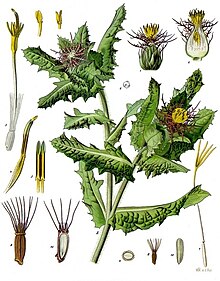Benedictine herb
| Benedictine herb | ||||||||||||
|---|---|---|---|---|---|---|---|---|---|---|---|---|

Benedictine herb ( Centaurea benedicta ) |
||||||||||||
| Systematics | ||||||||||||
|
||||||||||||
| Scientific name | ||||||||||||
| Centaurea benedicta | ||||||||||||
| ( L. ) L. |
The Benedictine herb ( Centaurea benedicta , in older literature mostly Cnicus benedictus ) is a species of the genus knapweed ( Centaurea ) in the subfamily of the Carduoideae within the family of the Asteraceae . It is used as a medicinal plant.
description
Vegetative characteristics
The Benedictine herb grows as a thistle-like, annual , herbaceous plant and reaches heights of usually 10 to 40, rarely up to 60 centimeters. The stalk is erect, branched at the top, spider-like shaggy in all parts and additionally hairy in the upper section. The alternate leaves are up to 30 inches long and 8 inches wide. They are green, shaggy and hairy with glandular hairs, with conspicuous white veins on the underside. The leaf blade is elongated, elongated-lanceolate in the upper section of the stem, its edge is curved like a saw-tooth, occasionally incised to the central vein and then weakly pinnate, its edge prickly. The plant has a basal rosette of leaves, the lower leaves are stalked, the upper ones sessile and encompassing the stalk.
Generative characteristics
The typical cup-shaped inflorescences of the composites are solitary in the species. The bracts of the basket, standing in a few rows, are colored green, the outer ones have a simple one, the inner ones are longer and have a long, pinnate-shaped spine. The flower heads, which are also often surrounded by dense leaves, reach 25 to 35, rarely up to 40 millimeters in length and (15-) 25 to 30 millimeters in diameter. They contain many yellow tubular flowers , the outer ones of which are reduced in size and sterile. The flower base bears numerous chaff leaves between the flowers. The fruits ( achenes ) are cylindrical, they are about 6 to 8 millimeters long and yellow-brown in color, with longitudinal ribs and a serrated upper edge. Their pappus is double-rowed, the inner row of hairs much shorter, and colored yellow.
The flowering time in Central Europe is in midsummer, until September.
The number of chromosomes is 2n = 22.
Occurrence
The Benedictine herb is native to the Mediterranean region and Asia Minor , from Portugal in the north to France and Italy in the south, and from the Balkans to Turkey in the east and North Africa. In Central and Eastern Europe and the British Isles, the Benedictine herb was cultivated and feral as a medicinal plant. It is also a neophyte in many other parts of the world .
The Benedictine herb is a character species of the Hordeetum from the Sisymbrion Association in Central Europe .
use

The bitter taste of the plant parts is typical. The leaves and the flowering ends of the stems are used medicinally.
The most important group of ingredients are the bitter substances with the main components artemisiifolin , cnicin and salonitenolid . The drug (Cnici benedicti herba, Cardui benedicti herba) contains about 0.2% cnicine. Other ingredients are essential oils with terpenes ( citral , cymen , fenchone ), flavonoids and triterpenes . The essential oil of Benedictine herb, which was used for purulent skin ulcers in the Middle Ages, has a bacteriostatic effect, according to Weiss, especially against staphylococci.
toxicology
The Benedictine herb has a certain allergy potential . This mainly affects people with allergies to aster flowers. Allergic reactions to the active ingredient cnicin could be observed in mice and rats. The dose of cnicine in the context of phytotherapy is usually below the dose of acute toxicity . Preparations with a high dose of cnicin as a pure substance can, however, cause irritation in the pharynx, throat and esophagus, which can range from disorders of the gastrointestinal tract to nausea, cramps and diarrhea with fever.
Taxonomy
It was first published under the name ( Basionym ) Cnicus benedictus in 1753 by Carl von Linné in Species Plantarum , 2, page 826. The new combination for the valid name Centaurea benedicta (L.) L. was published in 1763 by Carl von Linné in Species Plantarum , 2. Edition, p. 1296 published. Other synonyms for Centaurea benedicta (L.) L. are: Carbenia benedicta (L.) Arcang. , Cnicus bulgaricus Panov .
For a long time, the species was regarded as Cnicus benedictus , as the only species of a monotypical genus Cnicus , which Centaurea mainly distinguished by the toothed edge of the achenes . Phylogenomic studies, in which the relationship is determined by comparing homologous DNA sequences, then clearly showed that the species must belong to the genus Centaurea . Today it is placed in a monotypical section Cnicus within the species-rich subgenus Centaurea .
Common names
It is also called cardiac edicts, Benedictine thistle, Benedictine card, Benedictine root, bitter thistle, St. Bernard root, Bornwort, thistle herb, spider thistle or adder (n) herb. Made or for the blessed thistle also passed the other German common name : Small Cross Wurz, plane sealing ( Middle High German ), Benedicta, Benedicte (Middle High German), Benedictenwurz, Benedictine thistle, Berlin herb St. Bernard herb ( Silesia ), Bern Wurz ( Middle Low German ), Bitter Thistle, Born Wurz (Silesia) , Brunword, Brunworz, Cardobenedict, Kardobenediktenkraut, Crewzwurtz (Middle High German), Crucewort (Middle Low German), Cruswurtz (Middle High German) and Crützwurz (Middle High German).
More pictures
Habit before flowering
swell
Individual evidence
- ↑ D. Lange: Cnicus. In Oskar Sebald, Siegmund Seybold, Georg Philippi, Arno Wörz (editor): The ferns and flowering plants of Baden-Württemberg. Volume 6: Special part (Spermatophyta, subclass Asteridae): Valerianaceae to Asteraceae. Eugen Ulmer, Stuttgart (Hohenheim) 1996, ISBN 3-8001-3343-1 ., On page 297.
- ^ TG Tutin, VH Heywood, NA Burges, DM Moore, DH Valentine, SM Walters, DA Webb (editors): Flora Europaea. Volume 4: Plantaginaceae to Compositae (and Rubiaceae). Cambridge University Press, Cambridge 1976, ISBN 0-521-08717-1 . on pages 138–139.
- ↑ a b Erich Oberdorfer : Plant-sociological excursion flora for Germany and neighboring areas . With the collaboration of Angelika Schwabe and Theo Müller. 8th, heavily revised and expanded edition. Eugen Ulmer, Stuttgart (Hohenheim) 2001, ISBN 3-8001-3131-5 , pp. 974 .
- ↑ a b Werner Greuter (2006+): Compositae (pro parte majore). In: Werner Greuter, E. von Raab-Straube, (Ed.): Compositae. : Datasheet Centaurea benedicta at Euro + Med Plantbase - the information resource for Euro-Mediterranean plant diversity .
- ↑ a b Association for Medicinal and Spice Plants SALUPLANTA e. V. Bernburg: Handbook of Medicinal and Spice Plant Cultivation , Volume 1, self-published, 2009, ISBN 3-935971-54-0 .
- ^ Rudolf Fritz Weiss: Textbook of Phytotherapy. 5th edition Stuttgart 1982, p. 63.
- ↑ N. Garcia-Jacas, A. Susanna, V. Mozaffarian and R. Ilarslan (2000): The natural delimitation of Centaurea (Asteraceae: Cardueae): ITS sequence analysis of theCentaurea jacea group. Plant Systematics and Evolution, 223 (3/4): 185-199.
- Jump up ↑ A. Hilpolt, N. Garcia-Jacas, R. Vilatersana, A. Susanna (2014): Taxonomical and nomenclatural notes on Centaurea: A proposal of classification, a description of new sections and subsections, and a species list of the redefined section Centaurea. Collectanea Botanica 33: e001. doi: 10.3989 / collectbot.2013.v33.001
- ↑ H. Fischer: Medieval botany. P. 265.
- ^ Georg August Pritzel , Carl Jessen : The German folk names of plants. New contribution to the German linguistic treasure. Philipp Cohen, Hannover 1882, page 104. ( online ).
literature
- Hans J. Vermeer : "Cardo benedicta das edlist krautt". Manuscript texts from Vienna, Harbur and Bohemia. In: Specialist literature of the Middle Ages. Festschrift Gerhard Eis. Stuttgart 1968, pp. 421-432.
Web links
- Cnicus benedictus L., Benedictine herb. In: FloraWeb.de.
- Benedictine herb . In: BiolFlor, the database of biological-ecological characteristics of the flora of Germany.
- Thomas Meyer: Data sheet with identification key and photos at Flora-de: Flora von Deutschland (old name of the website: Flowers in Swabia ).
- David J. Keil, Jörg Ochsmann: Centaurea : Centaurea benedicta , p. 192 - same text online and printed work , In: Flora of North America Editorial Committee (Ed.): Flora of North America North of Mexico , Volume 19 - Magnoliophyta: Asteridae , part 6: Asteraceae, part 1 (Mutisieae – Anthemideae) , Oxford University Press, New York and Oxford 2006, ISBN 0-19-530563-9 .
- Cnicus benedictus as a poisonous plant at www.gifte.de .
- The Benedictine herb as a medicinal plant at www.awl.ch




